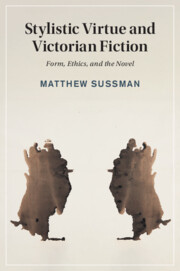Book contents
- Stylistic Virtue and Victorian Fiction
- Cambridge Studies In Nineteenth-Century Literature And Culture
- Stylistic Virtue and Victorian Fiction
- Copyright page
- Contents
- Illustrations
- Acknowledgments
- Introduction What Is Stylistic Virtue?
- Chapter 1 Stylistic Virtue and the Rise of Literary Formalism
- Chapter 2 Stylistic Virtue between Moralism and Aestheticism
- Chapter 3 Virtue Theory and the Nature of the Aesthetic
- Chapter 4 Thackeray’s Grace
- Chapter 5 Trollope’s Ease and Lucidity
- Chapter 6 Meredith’s Fervidness
- Afterword Stylistic Virtue and Literary Value
- Notes
- Bibliography
- Index
- Cambridge Studies In Nineteenth-Century Literature And Culture
Introduction - What Is Stylistic Virtue?
Published online by Cambridge University Press: 11 June 2021
- Stylistic Virtue and Victorian Fiction
- Cambridge Studies In Nineteenth-Century Literature And Culture
- Stylistic Virtue and Victorian Fiction
- Copyright page
- Contents
- Illustrations
- Acknowledgments
- Introduction What Is Stylistic Virtue?
- Chapter 1 Stylistic Virtue and the Rise of Literary Formalism
- Chapter 2 Stylistic Virtue between Moralism and Aestheticism
- Chapter 3 Virtue Theory and the Nature of the Aesthetic
- Chapter 4 Thackeray’s Grace
- Chapter 5 Trollope’s Ease and Lucidity
- Chapter 6 Meredith’s Fervidness
- Afterword Stylistic Virtue and Literary Value
- Notes
- Bibliography
- Index
- Cambridge Studies In Nineteenth-Century Literature And Culture
Summary
The introduction sets up the book’s theoretical terrain by providing a synoptic history of stylistic virtue from Aristotle to the present. It claims that stylistic virtues have typically encoded two ways of thinking about style: a referential one that regards style as an embodiment of underlying character and an autonomous one that sees style as conveying an independent character of its own. It explains that the book’s overarching purpose is to unfold the autonomous conception of style and defends its approach through the analysis of an extended Victorian example (“lightness” in Robert Louis Stevenson's work). It concludes by showing that stylistic virtue offers a fresh conceptual framework for understanding the aesthetic value of fiction in ways not captured by recent work in either ethical or formalist criticism.
- Type
- Chapter
- Information
- Stylistic Virtue and Victorian FictionForm, Ethics, and the Novel, pp. 1 - 25Publisher: Cambridge University PressPrint publication year: 2021

